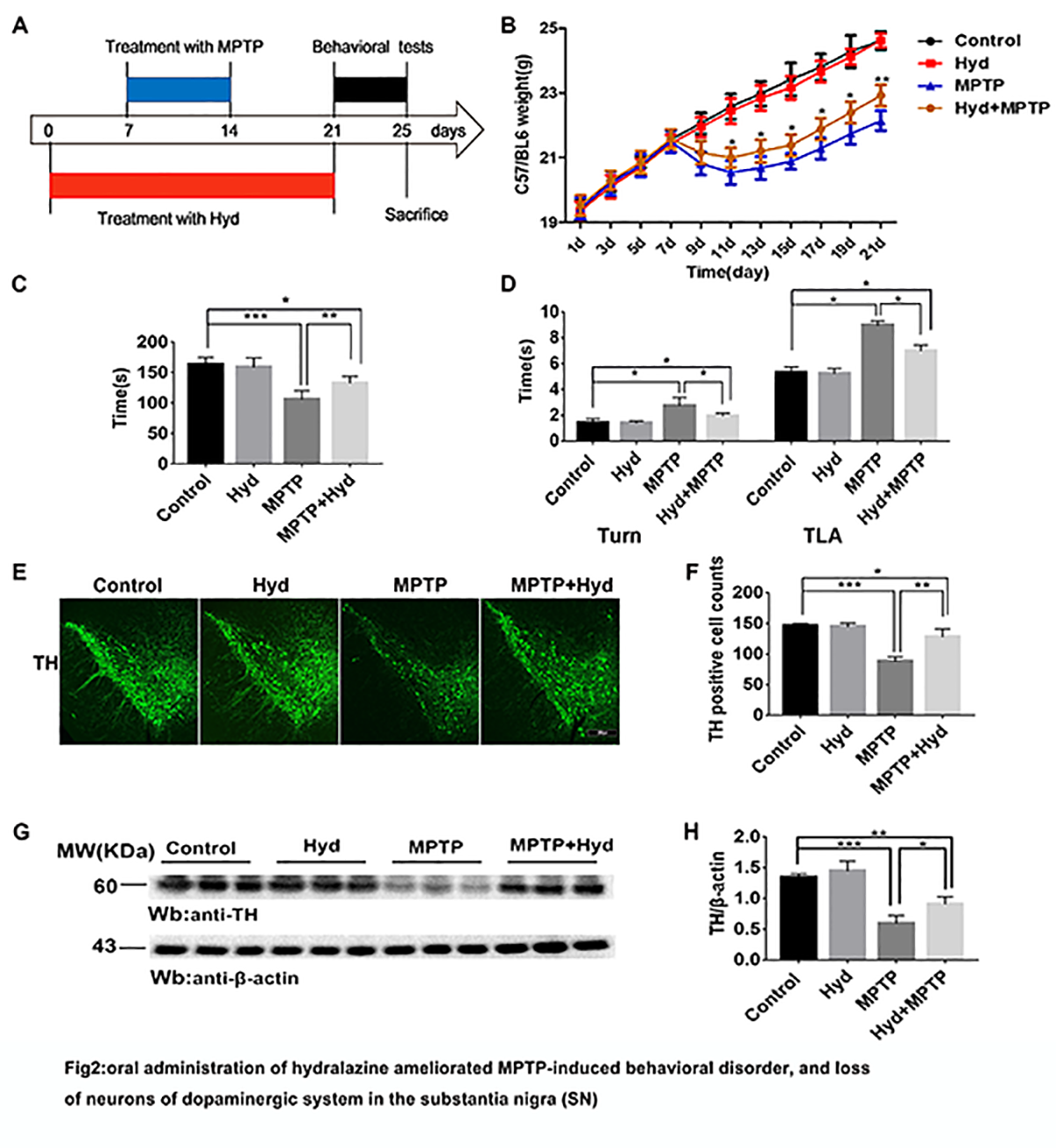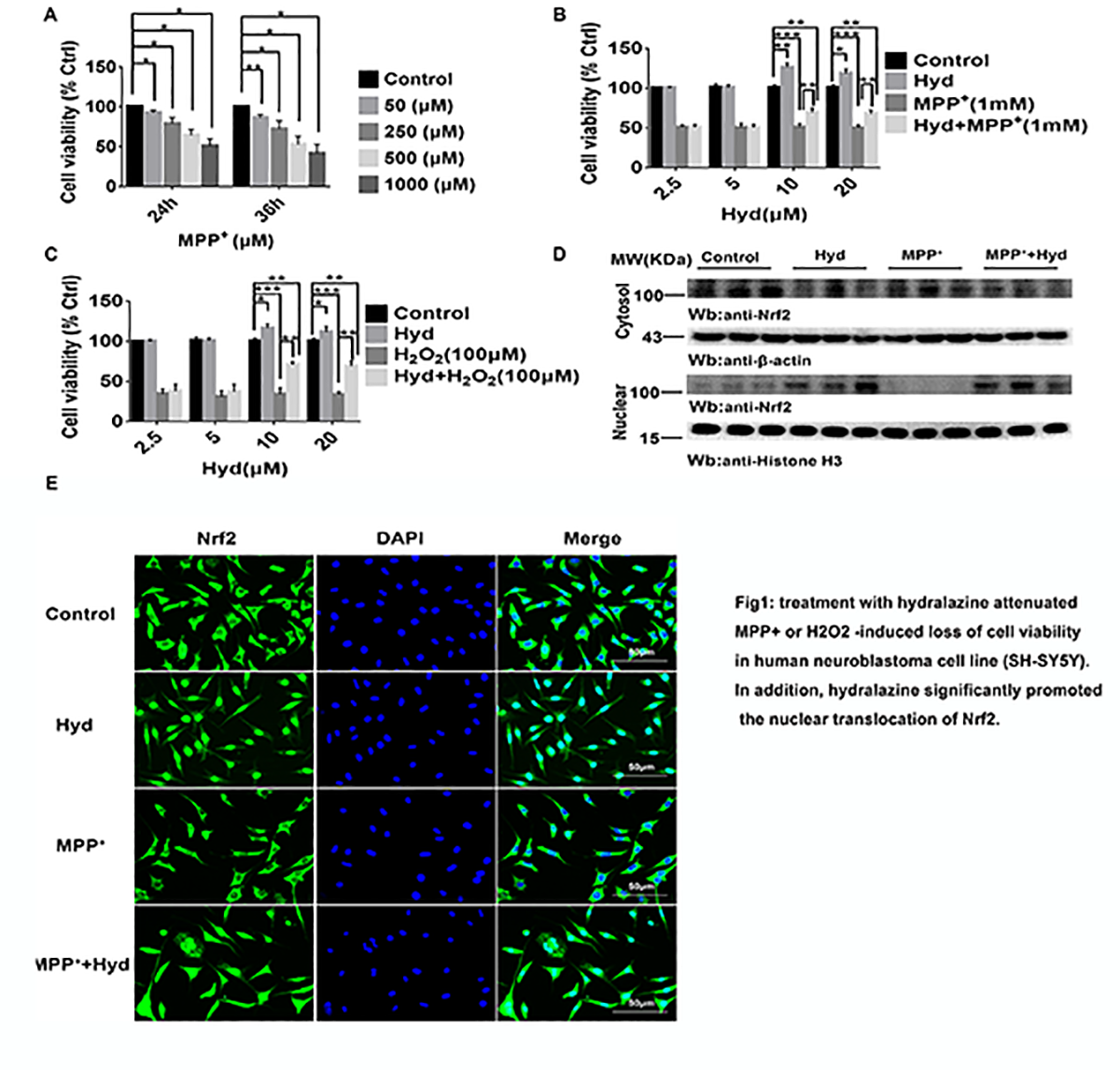Session Information
Date: Monday, September 23, 2019
Session Title: Neuropharmacology
Session Time: 1:45pm-3:15pm
Location: Les Muses Terrace, Level 3
Objective: In this study, we tested whether hydralazine can attenuate 1-Methyl-4-phenylpyridinium (MPP+) and 1-methyl-4-phenyl-1,2,3,6-tetrahydropyridine (MPTP)- induced neurotoxicity in vitro and in vivo by activating Nrf2 and its downstream network of antioxidative genes.
Background: Ample empirical evidence suggests that oxidative stress is involved in the pathogenesis of Parkinson’s disease (PD) . The nuclear factor E2-related factor 2 (Nrf2) is known to activate several antioxidant response element (ARE)-driven antioxidative genes that prevents oxidative stress in vitro and in vivo. Moreover, it was documented that hydralazine is a potent Nrf2 activator.
Method: SHSY5Y cells were subjected to hydralazine, H2O2 or MPP+ treatment. SiRNA interference were performed by treating the cells with with Nrf2 SiRNA or control SiRNA. After transfection for approximately 24h, SHSY5Y cells were exposed to hydralazine with or without MPP+. After these treatments, cells were used for biochemical analysis. Before, during, and after MPTP 30 mg/kg (i.p.) administration for 7 days, the mice were given hydralazine (Hyd) 51.7 mg/kg per day by oral gavage for 3 weeks. Behavioral test of the animals were performed after the last oral gavage, after behavior test, mice were killed for further analysis.
Results: We found that treatment with hydralazine attenuated MPP+ or H2O2 -induced loss of cell viability in human neuroblastoma cell line (SH-SY5Y). In addition, hydralazine significantly promoted the nuclear translocation of Nrf2, and upregulated the expression of its downstream antioxidative genes. Further, knockout of Nrf2 abolished the protection conferred by hydralazine on MPP+ -induced cell death. Similar findings were observed in vivo. Before, during, and after MPTP 30 mg/kg (i.p.) administration for 7 days, the mice were given hydralazine (Hyd) 51.7 mg/kg per day by oral gavage for 3 weeks. Oral administration of hydralazine ameliorated oxidative stress, MPTP-induced behavioral disorder, and loss of neurons of dopaminergic system in the substantia nigra (SN) and striatum, all of which were attributed to its ability to activate the Nrf2-ARE pathway.
Conclusion: This study shows that hydralazine as a potent Nrf2 activator, increases the expression of Nrf2 downstream ARE target genes and confers strong neuroprotection in model of PD both in vitro and vivo in a Nrf2 -independent manner.
To cite this abstract in AMA style:
XF. Guo, T. Wang, J. Huang, N. Xiong, C. Han, K. Ma, Y. Xia, F. Wan, JJ. Hu, SJ. Yin, L. Kou, YD. Sun, JW. Wu. Hydralazine protects nigrostriatal dopaminergic neurons from MPP+ and MPTP induced neurotoxicity: Roles of Nrf2-ARE signaling pathway [abstract]. Mov Disord. 2019; 34 (suppl 2). https://www.mdsabstracts.org/abstract/hydralazine-protects-nigrostriatal-dopaminergic-neurons-from-mpp-and-mptp-induced-neurotoxicity-roles-of-nrf2-are-signaling-pathway/. Accessed April 3, 2025.« Back to 2019 International Congress
MDS Abstracts - https://www.mdsabstracts.org/abstract/hydralazine-protects-nigrostriatal-dopaminergic-neurons-from-mpp-and-mptp-induced-neurotoxicity-roles-of-nrf2-are-signaling-pathway/


